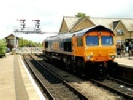Archive Section




Welcome to the story of Vennbahn – the world’s only railway that belonged to one country, yet was inside another.
The Vennbahn (meaning Fen Railway) is a now-
Here it is important to note that, under the current international regulations, not just the track, but five metres of land on either side of it, along with all the buildings and installations, belong to the country that owns the railway.
Built in 1889 as a fully German railway, Vennbahn was given to Belgium by the 1919 Treaty of Versailles in the aftermath of the First World War. After some years of deliberation, a special international commission agreed that “the trackbed, with its buildings between Raeren and Kalterherbert”, was to be ceded to Belgium, whereas the resulting five enclaves between the line and the Belgian border were to remain part of Germany.
The German names of all five stations onthe stretch were retained, freight charges and fares could be paid in either German or Belgian currency, and countless German regulations about ticket-
On the 18th May 1940, Hitler ordered that Belgium’s former German regions be re-
By 1990, the railway was no longer commercially viable, and the local community was trying to raise money to transform it into a tourist attraction – a kind of would-
In 2003/04, the southern end of line was still operating as a railway, however, further north at Raeren station, the only trains moving were on the screen-
Herr Hungs was then Vennbahn’s only employee. His German company, with the tongue-
Today, only the station building survives, which, although on Belgian territory, is typically Prussian in its design and architecture – a reminder of Vennbahn’s ‘enclave-
The Vennbahn has not disappeared entirely as an odd geopolitical phenomenon, and it is hoped that at least some of the carefree German and Belgian bikers peddling along the new asphalted cycle path will remember the uniqueness of the very ground they are riding on.
The last train to operate over the line (partially) was on the 7th August 2004, when a special excursion ran from Brussels Midi via Trois Ponts to Sourbrodt, plus the connected branch line to Büllingen. The train was billed as ‘Adieu a la Vennbahn’, and was hauled by locomotives belonging to both SNCB (Belgian Railways) and CFL (Luxembourg Railways).
On the 28th April 2012, one final train did reach Raeren, (although arriving from the direction of Liège/Eupen in Belgium). However, by this date, the rails beyond the station which connected into the Vennbahn, had long since succumbed to the encroaching undergrowth.
As a footnote, it is known that a small group of members from The L&CI were on both of these trips, although at the time, they probably didn’t realise their place in history
© Text Stuart Smith
From the December 2019 Newsletter